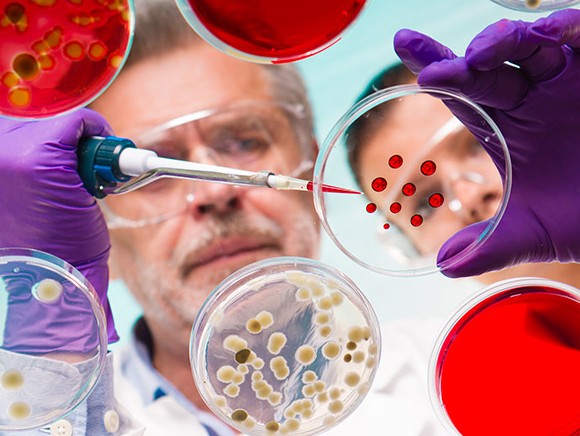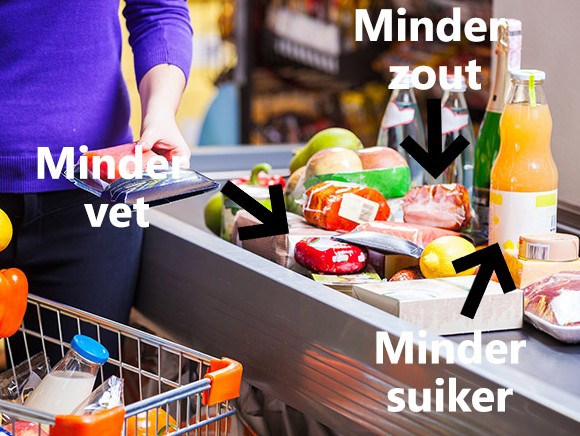
Less salt, less saturated fat and fewer calories (sugar and fat) in products – that is the key objective of the Dutch National Agreement to Improve Production Composition. However, reducing the salt, sugar and fat content in products creates risks related to shelf life and food safety. How can you take those risks into account in product reformulation?
In 2015, the Dutch minister of public health, welfare and sport reached agreements with industry bodies representing food manufacturers, retailers, catering companies and foodservice companies1 to make the current product offering ‘more healthy’ across the board. The National Agreement to Improve Production Composition that was signed by all those concerned contains ambitious targets for the reduction of the levels of salt, saturated fat and calories (sugar and fat). The Netherlands Food and Consumer Product Safety Authority (NVWA) recently presented the results of a study2 of the latest progress in the reduction efforts. The sodium and/or saturated fat contents of tomato-based sauces, soups, stocks and meat products were investigated. The results revealed that 93% of the sauces, 75% of the soups and stocks and 90% of the meat samples comply with the agreed maximum level for sodium. Of the meat samples tested, 77% comply with the agreed level for saturated fat.
The microbiological shelf life of food products is determined by intrinsic and extrinsic factors in combination with the microflora present in the product. The following aspects are seen as intrinsic factors: the presence of nutrients, pH value, aw value, potential for oxidation/reduction and the possible presence of antimicrobial substances. Extrinsic factors include, among other things: the storage temperature (refrigeration/freezing), the duration of storage, the storage atmosphere (vacuum, MAP), the intensity of any heat that is applied and the functionality of the packaging.
Water activity describes the energy status or escaping tendency of the water in a sample. It indicates how tightly water is ‘bound’, structurally or chemically, in products. Besides ‘bound’ water there is ‘free’ available water in a product. The availability of free water is of major importance for microorganisms. If no free water is available, microorganisms have no opportunity to develop. The addition of salts, sugars or other soluble substances, for example, reduces the availability of free water in a product. This means that the microorganisms have to work harder to utilise what free water there is, thus limiting their ability to multiply. It has been shown that reducing the amount of free water available in a product through additives restricts the growth of certain microorganisms (Table 1).
One way to express the amount of free water available for microorganisms is the water activity, which is expressed as the aw value. The water activity is calculated by dividing the vapour pressure of water in the material to be investigated by the vapour pressure of pure water at the same pressure and temperature. The aw value ranges between 0 for a completely dry product and 1 for pure water. Increasing the level of salt or sugar in a product lowers the aw value of that product. Replacing sodium chloride (table salt) with a different type of salt (for instance potassium chloride) also affects the change in the product’s aw value. Table 2 shows the extent to which other types of salt have a similar effect as sodium chloride in terms of reducing the water activity. Glucose has a much less pronounced effect on the water activity than salt does.
Table 1. Minimal aw values for the growth of some microorganisms
| Aw
|
Bacteria
|
Yeatst | Moulds |
| 0,98
|
Pseudomonas, Campylobacter
|
|
|
| 0,97
|
Clostridium botulinum (type B, E)
|
|
|
| 0,95
|
Bacillus, Escherichia coli
|
|
|
| 0,93
|
Lactobacillus, Clostridium perfringens
|
|
Rhizopus, Mucor
|
| 0,92
|
Listeria monocytogenes
|
Rhodotorula
|
|
| 0,91
|
Staphylococcus aureus (anaëroob)
|
|
|
| 0,90
|
Micrococcus
|
Saccharomyces
|
|
| 0,88
|
|
Candida
|
Cladosporium
|
| 0,87
|
|
Debaryomyces
|
|
| 0,86
|
Staphylococcus aureus (aëroob)
|
|
|
| 0,85
|
|
|
Penicillium
|
| 0,75
|
Holafielen
|
|
|
| 0,65
|
|
S. Rouxii
|
Aspergillus |
In most cases, reducing the fat content of a product causes the moisture content to rise. As a result, based on the amount of added salts or sugars in the product remaining the same, the water activity will increase and potentially support the growth of microorganisms. Nevertheless, it is possible to adapt formulations in order to reduce salt, sugar and fat without this necessarily affecting the shelf life or food safety.
Table 2: Overview of possible additives to replace NaCl while maintaining aw
| Additive | Formula
|
Needed (in %) to replace 1% NaCI to maintain the same aw |
| Sodium chloride
|
NaCl
|
1.0
|
| Potassium chloride
|
KCI
|
1.3
|
| Calcium chloride
|
CaCl₂
|
1.3
|
| Ammonium chloride
|
NH₄Cl
|
0.9
|
| Magnesium chloride
|
MgCl₂
|
1.1
|
| Potassium sulfaat
|
K₂SO₄
|
2.0
|
| Magnesium sulfaat
|
MgSO₄
|
2.0
|
| Potassium lactaat
|
C₃H₅O₃K
|
2.2
|
| Potassium acetaat
|
CH₃COOK
|
1.7
|
| Glucose
|
C₆H₁₂O₆
|
6.2
|
Intrinsic and extrinsic factors all affect the shelf life of a food product in their own way. The simultaneous application of several different factors makes it possible to extend the shelf life by more than would be expected based on the sum of the individual factors. In 1995 Leistner wrote a review article3 on this matter, looking at the application of ‘hurdle technology’. Over the past 20 years hurdle technology has been intelligently applied with increasing regularity, and more has also become known about principles of important preservation factors (both intrinsic and extrinsic ones) for foodstuffs and how they interact with one another. The study into how extending the shelf life of products affects the physiology and behaviour of microorganisms in foodstuffs (their homeostasis, metabolic exhaustion, stress reactions, etc.) has also provided insight into the effect of hurdle technology.
One example is Listeria monocytogenes. The growth of these bacteria is reduced at 15% salt, a pH lower than 4.1 or a temperature below -0.4°C. By now combining a salt content of 5% with a pH of 5.5, Listeria does not multiply at temperatures less than 14°C4.
When reducing the fat content in a product such as a sauce or a meat product, manufacturers must take the nature of the replacement ingredients into account. A substitution of fat can increase the product’s moisture content. Based on the dissolved salts in the product remaining the same, the aw value rises which has an impact on the shelf life and potentially also food safety.

In a number of cases the application of the intrinsic factors is limited, e.g. because of legislation restricting the use of additives or because of an undesirable effect on the flavour or texture. In that case, the solution can be found in extrinsic factors that can be utilised to achieve the desired level of food safety. One of the most common applications is MAP packaging for meat products which can also be stored at a lower temperature. Another well-known example is refrigerated storage, e.g. of jam that contains less added sugar or of low-fat mayonnaise. These combinations ensure that the product still has a sufficiently long shelf life.
________________
1 FNLI, CBL, KHN and Veneca
2 Netherlands Food and Consumer Product Safety Authority, Monitoring van het keukenzout- en verzadigd vetgehalte in levensmiddelen waarvoor afspraken zijn gemaakt in het Akkoord Verbetering Productsamenstelling 2016 (‘Monitoring the table salt and saturated fat content in food products which are subject to agreements in the National Agreement to Improve Production Composition 2016’), publication date 6 April 2017.
3 Leistner, L., Gorris, L.G.M. Food preservation by hurdle technology, a review. Trends in Food Science & Technology February 1995 (vol. 6) 41-46
4 Wareing, P. Stuart, F., Fernandes, R., Factors affecting the growth of micro-organisms in foods. Micro-facts 2011. ISBN 978-1-905224-84-5
Source: Foto petrischaaltjes: ©Matej Kastelic/Shutterstock.com. Foto boodschappen: ©Photobac/Shutterstock.com